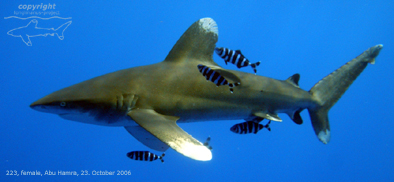Carcharhinus longimanus...
...is one of the few shark species, whose scientific name
is almost as widely known as its popular name, the Oceanic Whitetip Shark.
It is considered to be one of the most abundant pelagic sharks, with a distribution
range covering the off-shore, deep-ocean tropical and subtropical waters
worldwide.
In the Egyptian part of the Red Sea, oceanic whitetips fairly regularly
show up in the vicinity of drop-off reefs, such as Brother Islands, Abu
Kizan (Daedalus Reef), Abu Hamra (Elphinstone), and - in parts - St. Johns.
Their large, rounded first dorsal fin, wing-like pectorals and colour markings
on all fins make them easily recognizable to any observer. White tips are
present on the first dorsal, pectoral, pelvic and caudal fins. The photograph
below also shows the relatively short and bluntly rounded nose, the overall
built, and the brownish body coloration.

Oceanic whitetips grow to a maximum length of 4 metres, though most individuals in the Red Sea seem to measure less than 3 m. They reach sexual maturity at a length of 1,7 - 1,9 m at an age of about 4-5 years. Mating in the northwestern Atlantic Ocean and in the southwestern Indian Ocean has been reported from the early summer months. After a gestation period of 10 - 12 months, a litter of 1 - 15 pups is born alive (viviparous). Litter size is proportional to size and age of the female, with each pup being about 60-65 cm long.
The main prey of Carcharhinus longimanus consists
of a variety of bony fish, such as jacks, tuna, mackerels, barracuda, etc.
They do however also feed on stingrays, sea turtles, sea birds, squid, and
garbage that is disposed of at sea. In encounters with other shark species,
oceanic whitetips tend to be aggressive and dominant, especially during
feeding activities.
The apparent lack of specialization in their diet might explain their inquisitiveness,
also around humans in the water. Preferring the upper layer of the water
column, they closely circle and sometimes bump into divers and snorkelers.
Problems with these sharks are most likely to occur, when food is present.
They are known to become competitive and very 'pushy' on these occasions
and great caution should be taken on the human side. Practically speaking,
it might be recommendable to leave the water as fast as possible, but in
a calm orderly fashion!
It is advisable to keep in mind that oceanic whitetips are predators, no pets !
Most encounters tend to be very calm and 'uneventful' (if that is the right term for getting such close looks at one or more of these magnificent creatures ...) - and highly enjoyable once you got used to the idea, that sharks swim right up to you instead of disappearing into the blue.
As for all shark species, the Longimanus is far more threatened by humans than the other way around. It is being directly targeted for human consumption as well as being a common bycatch species in tuna and other pelagic fisheries. Along with other open-ocean fish and shark species, numbers are declining worldwide, and are likely to continue doing so with the demand - especially for shark fins - increasing and no large-scale protective legislation in place. On the IUCN Red List of Threatened Species, Oceanic Whitetip Sharks worldwide were recently moved to 'vulnerable' status, in parts of the Atlantic Ocean, they were even found to be critically endangered...
source
For further information, see the main source for this text:
Baum, J., Medina, E., Musick, J.A. & Smale, M. 2006. Carcharhinus longimanus.
In: IUCN 2009. IUCN Red List of Threatened Species. Version 2009.1. www.iucnredlist.org.
Downloaded on 26 June 2009.

diving with oceanics...
| • |
insist
on being properly briefed before a potential encounter; |
|
| • |
only
enter the water if you are comfortable with the situation, and confident
that you can stay calm; |
|
| • |
do
not enter the water if there is any sign of feeding activity around
the boat; |
|
| • |
be
aware that you are most vulnerable on the surface, so control you
buoyancy at all times; |
|
| • |
if
you want (or need) to leave the water, do so in a calm and orderly
fashion; |
|
| • |
try
to avoid surfacing straight above a shark swimming below you; |
|
| • |
to
avoid oceanic whitetips coming to close for your comfort, staying
next or slowly retreating to the reef might help; |
|
| • |
do
not try to touch or in any way harass a shark; |
|
| • |
do
not be alarmed by a shark calmly circling you, just make sure to turn
with it and keep it in sight; |
|
| • |
look
around you from time to time to see if another shark is approaching
you from behind/underneath/above; otherwise one might sneak up to
you; |
|
| • |
generally,
sharks are more reluctant to closely approach groups of divers than
single ones; |
|
| • |
REMEMBER:
you are in the water with a wild predator, whose behaviour will never
be 100% predictable ! |